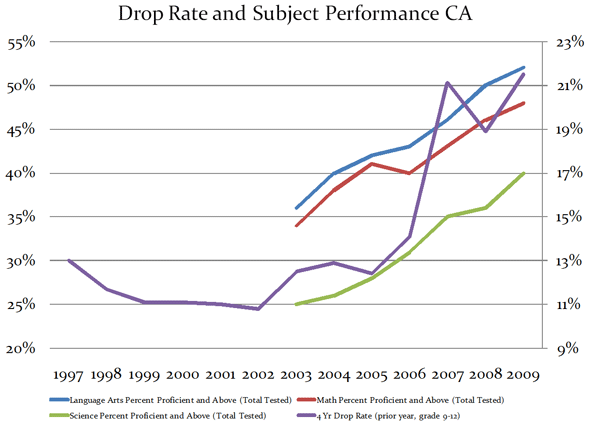
The No Child Left Behind Act became law in 2002. Among other things, it required standardized testing of students, beginning in 2003. The scores are used to evaluate the quality of the schools.
It sounds reasonable. Congress certainly thought so. It was co-authored in the Senate by Edward Kennedy (D-MA) and Judd Gregg (R-NH), while John Boehner (R-OH) and George Miller (D-CA) introduced it into the House. It passed both houses by huge bi-partisan majorities, 91-8 in the Senate and 384-45 in the House.
The Act’s passage also marked the low point in California's High School dropout rate.
In 2002, California’s High School dropout rate had been declining for several years. After the act’s passage, the dropout rate trend experienced an unprecedented reversal. What had been a declining trend became an increasing trend, one that continues today. After bottoming out at less than 11 percent in 2002, California’s High School dropout rate is now approaching 22 percent.
The costs of dropouts are enormous, both for the students who leave school and for society. A person without a High School education is economically crippled. For all but the very exceptional few, dropping out of High School is a sentence to a lifetime of poverty and drudgery. For many dropouts, a lifetime of poverty and drudgery is the best possible outcome. Far too many will be involved in drug abuse, dysfunctional or violent relationships, teenage pregnancies, and crime.
The costs to society are large. They include losses to crime, and the direct costs of subsidies, social programs, healthcare, prisons, and law enforcement. Those costs may be exceeded by the dropout’s output deficiency, that is, the difference between what the dropout would have produced with a decent education and what he or she actually produces.
One way to improve standardized test scores is to increase the retention of tested topics by the students. An easier way is to prohibit students who would perform poorly from taking the test. Since all students have to take the test, this means converting poorly-performing students into non-students, letting them drop out.
It looks to me like California’s educational establishment has opted for the easy way.
On the chart below, the purple line shows California’s dropout rate from 1997 through 2009; you can see the percentages on the right-hand side of the chart. The other lines show the percentage — on the left side of the chart — of California’s students who passed the standardized tests for Math, Language, and Science. California’s passing percentage in each field has increased lockstep as dropouts increased.
It is worse than that, though. The percentage of students passing the standardized tests has increased by about 15 percent, on average, while the percentage of students dropping out has just about doubled. That’s an extraordinarily expensive improvement.

Did the schools follow this strategy deliberately? You can't rule it out. People react to incentives, and the Act provides an incentive to abandon those who will likely perform poorly on the tests. Teachers will probably object to that, but we have no reason to believe that they should somehow be different that most people and ignore the incentives. Besides, we’ve already seen examples of teachers and administrators cheating on these tests.
Teachers assert that the solution to all of No Child Left Behind problems is to abandon it. The other solution, of course, is to fix the incentives. The way to do that would be to assign the schools a huge financial penalty for dropouts. Teachers and administrators would scream. They would tell us that dropouts result from problems at home and socioeconomic conditions.
No doubt, many students have terrible home conditions that put these children at a huge disadvantage, but those are exactly the children that we should be giving the most attention. A lousy home environment doesn't explain the sudden increase in dropouts. These issues have been with us for a very long time. I took my first college economics class, The Economics of Poverty, in the 1969-1970 school year. There is nothing about poverty today that we didn't discuss in that class, except that the returns to education have increased dramatically since then.
Failure to educate disadvantaged children guarantees that the perverse cycle of poverty and despair is perpetuated. Providing them with quality education, even with the active resistance of family, friends, culture, and the students themselves, is the only way to provide them with even the minimum hope for the upward mobility that government-provided education implicitly promises.
Abandoning our least advantaged children is unconscionable. If we are to have an egalitarian and merit-based society, we must reduce the dropout rate. The way to ensure that no one is abandoned is to penalize the school for dropouts. It sounds harsh, but we owe it to the students, and we owe it to ourselves.
Bill Watkins is a professor at California Lutheran University and runs the Center for Economic Research and Forecasting, which can be found at clucerf.org
Flickr Photo by kerryj.com: "On national standardised testing, from a brilliant educator in Western Australia - a student's view of national summative assessments".













girlsdoporn
The first several months of my site there were no comments; just give it time; now they come in like crazy every day! Thanks.
girlsdoporn
ca car insurance laws
Abandoning our least advantaged children is unconscionable. If we are to have an egalitarian and merit-based society, we must reduce the dropout rate.
http://www.carinsurancerates.com/california-car-insurance.html
Schools aren't designed for
Schools aren't designed for flexable learning and lately a lot of people noticed that. This is one of the major things that needs to change in the education field. Without such a change we could see even more drop outs.
The return of Torquemada
This is quite a piece of illogic. We are told that prior to NCLB, California schools were steadily improving; since NCLB, they have declined significantly. The conclusion: we need even more radical NCLB.
Huh?
It takes a fanatical, almost cultish devotion to something to use its acknowledged failure as a call for more of it, but that is just what we have here. Apparently Mr. Watkins believes that a single dose of his medicine has made us sick, but a double dose will cure us.
Mr. Watkins, so that the rest of us can see just how effective a school can truly be, I encourage you to share with us the dropout rate for California Lutheran University. Please be sure to provide a detailed demographic breakdown so that we can see how well you are doing with poor, minority, ESL, and mentally handicapped students. Please also be sure to show us your admissions policy so that we can see who gets excluded from your school. Given your unwavering certainty that a school should be able to graduate literally every single student who shows up in its classrooms, I am confident your own school is doing just that. I look forward to seeing the update to your post.
We need a high drop-out
We need a high drop-out rate.
It keeps the cost of labor down when people can't get access to better paying jobs. It means we get those toilets cleaned for cheap, etc.
Don't make the mistake of assuming that job payment is proportional to material productivity. It's still primarily a game of that supply to demand function, and a big supply of people who have no choice but to do shitty work means WE don't have to do it. And again we get them for cheap.
Mate. The guys who design your education systems are one step ahead of you. (wink!)
Interesting, but...
Doesn't it follow that if the drop-out rate doubles, that achievement test scores of the remaining students would naturally rise? This seems like a statement of the obvious.
The interesting question is whether the testing is motivated by, or has motivated, a desire to weed-out the lower performing students. This would certainly appear to be one consequence. But can it be proven?
If the hypothesis and conclusion of this article are correct, then it suggests that new policy is needed to deal with students who are on the drop-out track. Instead of wasting vast sums of money trying to keep them off this track, perhaps resources would be better spent preparing them for life that is less oriented toward the type of academic achievement that is measured by the standardized tests.